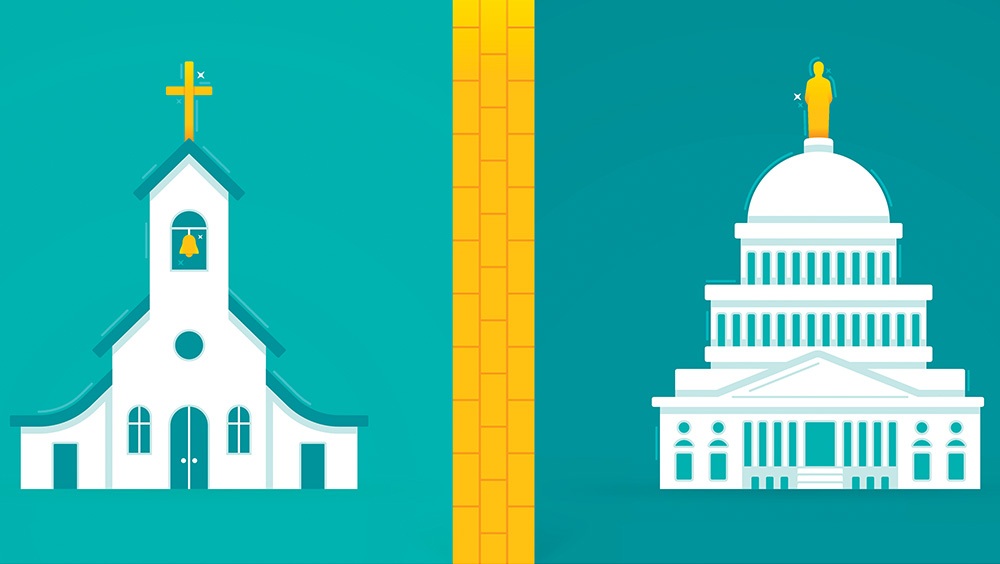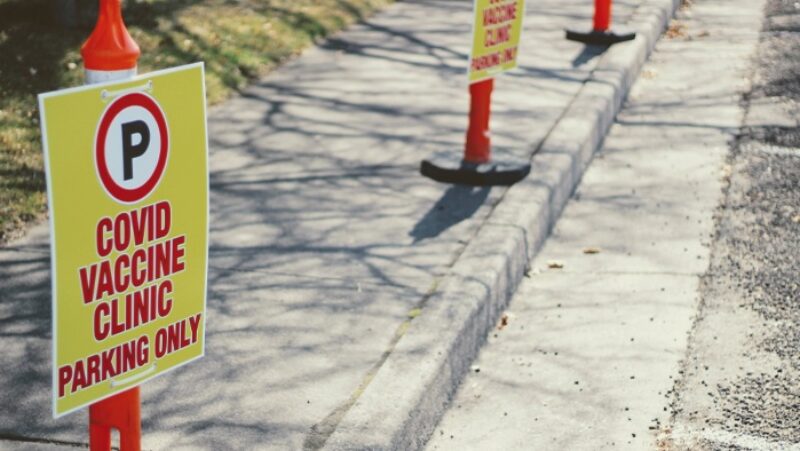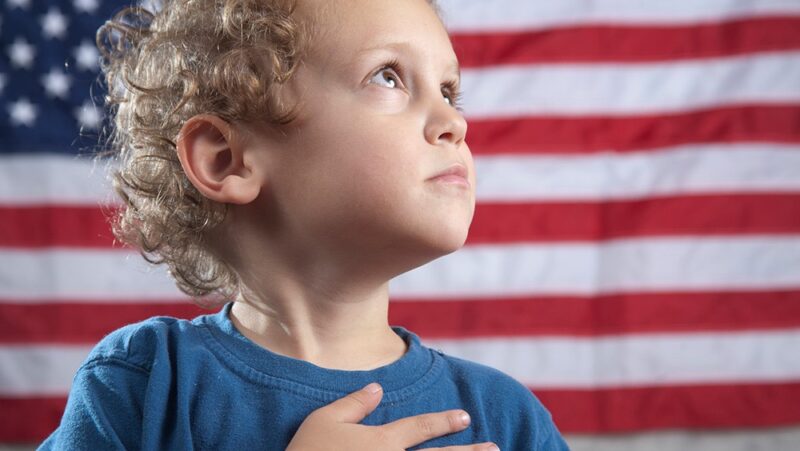The Establishment Clause: Everything to Know

Religious freedom in the United States is guaranteed by two provisions of the First Amendment to the U.S. Constitution.
One, commonly known as the establishment clause, has been interpreted by the U.S. Supreme Court to prevent government from either advancing (that is, establishing) or hindering religion, preferring one religion over others, or favoring religion over nonreligion.
The other, commonly known as the free exercise clause, protects the right of individuals and groups to practice their religion openly and freely without interference from government. Together these two clauses define and protect religious freedom.
“Congress shall make no law respecting an establishment of religion, or prohibiting the free exercise thereof …”
- Religious freedom clauses of the First Amendment to the U.S. Constitution
Balancing these two principles is often challenging, as seen in the religious freedom cases argued before the Supreme Court.
The 1947 landmark Supreme Court decision in Everson v. Board of Education applied the establishment clause to the states. The court said that under the Fourteenth Amendment, each state along with the federal government is subject to the First Amendment.
Since then, the court has proposed and applied a variety of legal tests for determining when the government violates the establishment clause.
How the establishment clause applies
Today, the establishment clause is understood by the courts as separating church from state on every level of government.
The First Amendment’s establishment clause is not the only law that prohibits government establishment of religion. State constitutions have their own establishment clauses.
It should be noted, however, that the establishment clause does not separate religion from politics or public life. Church-state separation is intended to prevent government from interfering with religious autonomy while also protecting government from religious control.
Although the establishment clause creates a line between religion and government in the United States, where exactly that line should be drawn has been hotly debated.
When the Supreme Court first ruled on the issue in Everson v. Board of Education, all nine justices endorsed the view that the First Amendment erected a “wall of separation between church and state,” adopting the view of “no establishment” held by founding fathers Thomas Jefferson and James Madison.
Critics of the court’s strict separation language point out that the phrase “separation of church and state” is not found in the Constitution. They also say it is misused to unfairly bar religion from public life in ways never intended by the framers of the First Amendment.
In recent decades, critics point to instances where church-state separation was used by some government officials to justify exclusions of religion that violate the Constitution, such as saying public school students cannot express their faith during the school day.
How much can the government accommodate religion?
The Supreme Court has made clear that allowing religious expression is permissible, and sometimes required, under the First Amendment.
When and if the establishment clause permits or requires accommodation of religious exercise is a much-debated question in the courts.
Most legal scholars view providing space for public school students to pray as permissible accommodation of free exercise under the establishment clause. If, however, school officials were to create a permanent prayer room or chapel, or in other ways use state resources to encourage or promote student prayer, their actions would doubtless be ruled unconstitutional establishment.
A more difficult question is whether the school must provide students with space to pray to accommodate their free exercise. If the school provides empty classrooms or other spaces for secular activities of students, then it is likely that the current courts would require that they accommodate religious students in the same way.
State-sponsored religious practices
By the 1960s, many public-school districts had already ended school-sponsored prayers.
New York, however, kept in place a nondenominational prayer to be recited in classrooms each morning. Although students could opt out, a group of parents opposed the practice as a violation of the establishment clause. Engel v. Vitale in 1962 was the first case challenging state-sponsored school prayers. In a 6-1 decision (two justices did not participate), the Supreme Court ruled in favor of the parents, holding that reciting state-written prayers in public schools was unconstitutional government promotion of religion.
The ruling was immediately misrepresented as “kicking God out of schools” by outlawing prayer, a myth that persists today. In fact, the Supreme Court has never banned student prayer in public schools. Instead, the court prohibited state-sponsored prayers. Under the First Amendment, students are free to pray alone or in groups, if their prayers do not disrupt the educational process.
A year later in School District of Abington Township, Pennsylvania v. Schempp, the Supreme Court stirred additional public outcry by striking down as unconstitutional school-sponsored Bible reading and the recitation of the Lord’s Prayer in public schools. The majority decided 8-1 that such practices violated the neutrality toward religion required of public schools by the establishment clause. By neutrality, the court meant not taking sides in religion and remaining neutral among religions as well as between religion and nonreligion.
Once again, critics said the court was exiling God from public schools. Some educators and religious leaders, however, focused on the need to study religion as part of a good education.
Teaching religion in public schools
Today, there is considerable teaching about religion in public schools and a growing number of religious studies electives.
The Supreme Court has refined the establishment clause ground rules for determining what is and is not permissible in public schools. For example, it has ruled that a “moment of silence” must be genuinely neutral (Wallace v. Jaffree, 1985). And the court has said that prayers at public school events are unconstitutional if organized by the school, even if delivered by a student (Santa Fe Independent School District v. Doe, 2000).
Since the 1980s, the Supreme Court said if government property is open for a variety of nongovernmental speech, religious speech cannot be excluded. By opening the door to student religious clubs, the court continued to move away from strict separation toward more accommodation for religion.
Today, most public school officials know that under the establishment clause they may neither force nor prevent religion. Public schools must treat religion and nonreligion with fairness and respect. Schools are also doing more to protect the religious freedom of students, including accommodating religious practices and beliefs, when possible. Finally, public schools today include more academic study of religion in the curriculum than in any previous era. Religion comes into public schools now, but mostly through the First Amendment door.
Aid to religious programs
Some state constitutions bar any government financial aid to religious institutions, sometimes referred to as “no aid” provisions.
“No aid” provisions in state constitutions have been sometimes applied to create a stricter separation of church and state than the U.S. Supreme Court requires under the establishment clause.
In 2002, for example, the U.S. Supreme Court in Zelman v. Simmons-Harris upheld an Ohio school voucher program because the use of vouchers at a religious school is the individual choice of parents and not aid to the school. By contrast, in 2018 the Montana Supreme Court struck down a school voucher program as a violation of the “no aid” clause in the state constitution.
In 2020, however, the U.S. Supreme Court substantially weakened “no aid” provisions in 37 state constitutions. According to the court majority in Espinoza v. Montana Department of Revenue, the state need not help fund private education, but if it does, religious private schools may not be excluded.
In Carson v. Makin (2022), the court ruled 6-3 that Maine may not exclude religious schools from a state tuition program. The court said that the state was not required to support religious education but if tuition assistance was provided to secular private schools, it must also be provided to religious private schools, including those with significant religious teaching.
Does “under God” violate the establishment clause?
It is important to remember that the establishment clause does not bar government officials from using religious language or invoking God at public events. If they do not seek to impose their religion on others, elected officials are free to express their convictions in religious or nonreligious terms.
Many Americans are confused by government-sanctioned descriptions of the United States as a nation “under God.” In 1983’s Marsh v. Chambers, for example, the court said legislative prayers are permitted, citing the “unique” and “unbroken” historical tradition of legislative chaplains.
Challenges to “under God” in the Pledge of Allegiance and other uses of God language by government have been dismissed over the years by both liberal and conservative justices. The language, some say, has lost religious meaning over time and is now purely ceremonial. Some court observers have suggested that the justices are aware of the public outrage that would follow any effort to scrub references to God from the pledge and elsewhere.
Why the founders opposed a state religion
Although many of the European immigrants who settled in North America came seeking religious freedom, they founded colonies with established state churches. Religious freedom was for the majority religious group. Religious freedom in America came about because competing religious traditions had to ensure peaceful coexistence and avoid religious conflict.
Rhode Island, though, had no established religion at all. It was created in 1636, after Roger Williams, a Puritan minister, was banished from Massachusetts Bay Colony as a heretic and troublemaker.
Williams insisted that the combination of church and state corrupts both. Keeping church and state separate was the only way to guarantee all people could be free to follow their own deepest beliefs, he said. Soon Jews, Quakers and others unwelcome elsewhere made their home in Rhode Island.
Some 140 years later in Virginia, Thomas Jefferson wrote a law to prevent that state from imposing religion. He especially opposed using tax money to fund churches. For the state to force people to support a religion they do not believe, Jefferson argued, is a violation of conscience that is both “sinful and tyrannical.” By enacting this law, the Virginia General Assembly became the first legislature in history to end the state church and guarantee religious freedom for all.
How the establishment clause became part of the Constitution
Framers of the First Amendment agreed on the need to prevent creation of a national church, a view widely supported in the country. But they clearly wanted to do much more, rejecting language that only prevented establishment of a “national religion” or “any particular denomination.” Instead, they adopted the phrase “no law respecting an establishment of religion,” a much broader definition of the purpose of the establishment clause. The main reasons for this language were:
- The need to protect an individual’s conscience by preventing the government from taxing people to support a religion that was not their own.
- The understanding that entanglement of church and state has led to oppression, division and violence throughout history.
- Preventing the establishment of religion was seen as essential for protecting government from religious tyranny and religion from government control.
Why the establishment clause applies to all levels of government
The Fourteenth Amendment’s due process clause says “…nor shall any State deprive any person of life, liberty, or property, without due process of law.” The term “liberty” has been interpreted by the court since 1925 to include the liberties guaranteed by the First Amendment. Through this doctrine, called incorporation, states are now subject to the First Amendment along with the federal government. Not until the 1947 case of Everson v. Board of Education did the Supreme Court explicitly apply the First Amendment’s establishment clause to the states.
Supreme Court tests for applying the establishment clause
Since the Everson decision, the Supreme Court has decided many establishment clause cases that have shaped the relationship of religion and government.
The most influential test for determining whether the government has unconstitutionally supported religion is referred to as the “Lemon test” from the 1971 decision Lemon v. Kurtzman. In Lemon, the court struck down a state program providing aid to religious elementary and secondary schools.
The Lemon test requires that government laws or actions (1) have a nonreligious purpose; (2) have a predominantly nonreligious effect; and (3) not create an “excessive entanglement” between government and religion. Failing to meet any one of these three would mean the program violated the establishment clause.
Critics of the test argued that it was vague, not historically supported and hostile to religion.
As Lemon became increasingly unpopular on the court, justices proposed alternative tests.
The “endorsement test” advocated by the late Justice Sandra Day O’Connor asks: Does a government action amount to an endorsement of religion, creating a perception in the mind of a reasonable observer that the government either endorses or disapproves religion?
In a holiday display case, Lynch v. Donnelly (1984), O’Connor’s endorsement test was influential in upholding as constitutional a government-sponsored holiday display with religious and secular symbols. The court found that the overall message of the display was celebration of the holiday season, not endorsement of religion. In the same case, however, the court struck down a free-standing crèche in the courthouse as an unconstitutional advancement of religion.
In the 1990s, Justice Anthony Kennedy proposed a “coercion test” under which government action only violates the establishment clause when it (1) provides direct aid to religion in a way that would tend to establish a state church, or (2) coerces people to support or participate in religion against their will. Like “endorsement,” the meaning of “coercion” can have many, often very subjective, interpretations – a point made by critics of both tests.
In Lee v. Weisman (1992), for example, the majority held that a middle school that invited a clergy person to offer a prayer at graduation was coercive because it required students to choose between attending their graduation or participating in prayer.
RELATED: Controversial commencement speakers and the First Amendment
Although the current Supreme Court has not defined how it tests when government action violates the establishment clause, in recent cases, the current majority has signaled a movement away from the endorsement and coercion considerations previously proposed as alternate tests and will now focus more on history and tradition.
The trend is toward even-handed neutrality. According to the majority of the current court, even-handed neutrality generally means requiring government to include religious institutions and individuals in funding programs open to nonreligious institutions and individuals.
The establishment clause protects freedom of religion for all of us
Despite complex, controversial, and often confusing Supreme Court decisions applying the establishment clause, the First Amendment framework of no establishment and free exercise continues to protect freedom of religion and belief for people of all faiths and none to a degree seen in few other nations. We may disagree about how high or low a “wall of separation,” but how fortunate we are to have that debate in a country constitutionally committed to religious freedom.
Charles Haynes is a senior fellow for religious liberty at the Freedom Forum.
Perspective: Divided Court Considers Religious Exemptions to Vaccine Mandates
Pledge of Allegiance in Schools: Do Students Have to Stand?
Related Content
Religion. Speech. Press. Assembly. Petition.
Learn about the First Amendment.

